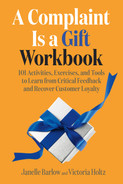CHAPTER 10
Powerful Phrases That Work

How many times have you heard someone say, “I’ll never forget what my grandmother/father/brother/boss/colleague said to me. It’s had an impact on me that has lasted forever.”
But how often do we say, “I’ll never forget what a customerservice representative said when I complained. It completely turned me around. I’ll never forget it.”
We don’t hear that too often! Why not? We have a chance to say something to our customers that matters. It’s our chance to have a lasting effect.
ACTIVITY
66
Words Matter
Most people don’t think that words matter regarding complaint handling. In fact, most people think of complaint handling as transactional. Yes, you can turn a customer-business relationship into something entirely transactional, but that’s no fun for the service provider or the customer.
When we give total weight to what words mean, we let customers know we seek a business relationship when we communicate with them. Through this communication we answer questions, fix problems, and form relationships.
LTIO: What words or phrases have you said to a customer in a complaint situation that you know impacted them positively? Write three phrases you know make a positive difference.

What words or phrases have you said to a customer that you know or suspect had a negative impact on the customer? This may require some deeper thinking because we tend to justify our words or don’t believe they have as much impact as we realize. List three phrases that might have made your complaint handling more difficult.

ACTIVITY
67
Powerful Complaint-Handling Phrases
Over many years, CSRs have developed powerful phrases that say to customers, “We want to help you.” In this activity, we share phrases that display helpfulness. Highlight the ones that appeal to you.
1. “Let me see what I can do.”—This phrase is an Apple service term. Janelle has heard it dozens of times when receiving help in Apple Stores or with AppleCare. This phrase means the customer may not get what they want, but it’s not an outright rejection. It holds out the hope that something is going to happen.
2. “Let’s work together to make you as satisfied as possible.”—Again, this is not an outright promise to make something happen, but it gets close. The phrase offers an element of hope. These words also speak of partnership: “We’re going to do something together.”
3. “Tell me everything that happened.”—When you ask the customer to give you a complete description of what happened, you’re saying you have time to listen. Keep in mind that you may spend an extra five minutes with the customer, but what you get back in loyalty is worth much more than what five minutes costs. It is a phrase that also says, “I trust you.”
4. “I know you are going to like this.”—You are affirming the customer’s choice. Everyone wants to know they have made a good choice, especially when they aren’t sure. If you aren’t sure, then don’t say this. Use it when you know it will work for them.
5. “That shouldn’t have happened.”—You are saying several things here. First, you are taking responsibility—not necessarily for your role in what happened but that someone in your business or elsewhere did something, and you want to acknowledge what they said. Second, you are saying that the quality standard of your company is higher than this. You are also implying that whatever happened will be fixed.
6. “Remember, you’ll also need . . .”—Be sure to tell customers what else they need to make their product work—such as batteries or a particular food to bring out the taste of whatever product you provided them.
7. “I’ll do this . . .”—Use definite language instead of saying something such as “I might be able to . . . ” Wishy-washy language makes customers nervous. Give them a precise time frame or at least one that falls within a time period. Don’t say four o’clock when what you mean is somewhere between four and four-thirty. If an exact time is tough for you to confirm, send a text message to tell them you are delayed. Keep communicating!
8. “You are important to me. I want to do my best for you.”—You have to believe this phrase yourself, or you shouldn’t say it. If you can’t sound as if you are genuine with some of these phrases, don’t use them. Do you truly want to do your best for them? Then say it. The customer will appreciate your assurance.
9. “I’m glad you called/came in. I want to resolve this for you as soon as possible.”—This phrase is particularly good to use when you know the customer has already spent some time on this problem. Customers like to hear this certainty. Speed sets a tone and shows you value the customer.
10. “Thank you for your information. With it I should be able to fix this quickly.”—You’re doing a couple of things with this phrase:
(1) thanking them for helping you with their information and
(2) assuring them that something is going to happen.
11. “Good morning, my name is Sam. How can I help you?”—Establish your identity. Unless your company has a specific policy of people not using their names, start to build a relationship by exchanging names. This shows that you aren’t hiding. Personalize whenever you can. And make sure it’s your name. Janelle often hears Western names when it’s clear the person is calling from India.
12. “You are fantastic. You were so helpful!”—Brag about them to them: “You were the most clearly spoken customer I’ve spoken with today,” “You were so patient. I can’t thank you enough,” and “You were very helpful, looking up that extra information so I could quickly help you.” Your customers want to know that you appreciate them for who they are. By the way, you don’t have to make anything up. There’s always something positive to say about someone.
13. “Let me check on that so I can be sure to get it right.”—Customers don’t mind if you don’t know everything. It’s best not to say, “I don’t know.” Tell them you will check to make sure you get it right. It’s the last part of those two phrases that the customer hears: “get it right.”
14. “Let me tell you what is happening.”—Customers like to be kept in the loop. If they have to wait on the phone before you can get back to them, pop in periodically and tell them what is happening. They will appreciate it. If the customer has to leave to handle something else, they won’t lose the connection with you because you’ll have a chance to discuss how much longer they will have to hold.
15. “I’m going to do something special for you.”—Of course, you only want to say this if you will do something special. It doesn’t have to be out-of-this-world special, just something they will appreciate. For example, you can give them a number to call you directly or say you will call them back so they don’t have to remain on hold.
16. “You made a good choice.”—Everyone wants to know they chose well. This is especially true if they are a little nervous about purchasing the product and now it has a problem. Assure them that the product is a good one, and even more importantly, that you’re going to stand by them until their product is fixed.
17. “What can I do to help you?”—It’s “I” not “we.” People want to feel you are responsible, and saying “I” does that.
18. “I look forward to seeing you again!”—If they are talking with you about a complaint, make sure this phrase doesn’t sound like you want them to have another problem. You liked “seeing” or “meeting” them because of who they are, and not because of their problems.
19. “I want to be fair to you. Let me check to see what kind of leeway I have to make this right for you.”—Fairness is critical to customers. They see it as something the company has the power to deliver. Customers feel at the mercy of whether companies will treat them fairly.
20. “Thank you for telling me. I am so sorry this happened, and I’m going to do everything I can to help you.”—Don’t forget the Gift Formula. It’s the best set of phrases to display helpfulness right at the beginning!
LTIO: List two phrases you will start to use.

Describe your customer’s reactions to your use of these phrases.

Notes:

ACTIVITY
68
Three Phrases in One
In this series of three phrases, you can identify yourself, describe the action you are taking, and then spell out the value that will happen.
1. Identity—Establish what will happen, either in person or leaving a voice message; for example, “Hi, this is Victoria. I’m calling to let you know we are continuing to work on the issue we talked about yesterday.”
2. Action—Tell them what you will do: “Here’s my next step. I’m going to . . .” or “I need from you . . .” or “Do this . . .”
3. Value—Make a value statement, such as “This will fix your problem,” “I guarantee you will save a lot of time,” or “You’ll have the replacement product in just a couple of days.”
One particularly good way to use this set of three phrases is when you leave a voice-mail message. Think through your identity, action, and value statements so you can record them perfectly. You can use these three statements in the middle of a long call and also to summarize your call at the end. If it helps, write down these action steps and place them by your computer, so you don’t have to think of new ones every time you make a call.
LTIO: Describe a situation where you need to get back to your customer on the telephone. Then describe your identity, action, and value statements.
Situation:_________________________________________________________
1. Identity statement:

2. Action statement:

3. Value statement:

Notes:


SELF-CHECK: Powerful Phrases That Work
What are three advantages of using preset phrases showing helpfulness to your customers that you know will work?

What are your absolute favorite phrases that you know will work with your customers?

What are three things to watch out for when using preset phrases showing helpfulness to your customers? What could go wrong?

